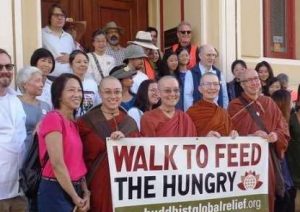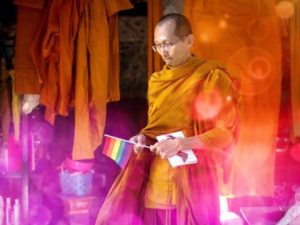There is a slightly muted, elegantly understated, force moving and shaking the entire 2500 year-old institution of Buddhism. That force is the collective, gentle but authoritative, chorus of women, which is determined to join the sonorous chanting of the predominantly male Buddhist hierarchy. The panel presentation (Women & Buddhism) concerning women was held on the 29th of November, not at the more spacious and well-known Lalit Hotel venue where I stayed, but at the smaller and lesser-known Park Hotel. That did not stop the panel however from being one of the most well-attended, and lively forums during the conference. The vibrant vitality in the conference room was not one born of gender antagonism, or of female bitterness at the thorny issue of bhikkhuni ordination, or of male fear at finally having to share the reins of spiritual authority and publicity. But there was a palpable sense of glad recognition in the air that day, especially on part of the audience gentlemen, that this was the time to listen.
Ironically, the session kicked off with the only male speaker of the panel, Gelek Rinpoche (one of the last to be educated at the great Drepung monastery). Gelek Rinpoche acknowledged that Buddhism developed in a patriarchal society based on Vedic ideals of male leadership. The ancient Indian culture he was born into was an evolving organism left behind from the Indo-Aryan migrations into the Indian subcontinent, who were themselves from the Indo-European and Proto-Indo-European cultures: chariot-drivers, sky-worshippers, warriors, priests, and heavily patriarchal. Yet the Buddha walked a different path, and his religion’s purpose was clearly to serve, protect and benefit all living beings. In the journey of Dharma, the struggle is already present to free oneself from destructive inner forces as well as external structural injustices. We need to remove, said Rinpoche, as many unnecessary obstacles as possible, and this includes sexism and misogyny.
The gentle force and presence of women in Buddhism is not about removing or revolutionizing the Vinaya – the canon of Buddhist law is here to stay. But, it is a time that no Buddhist is left behind, and that no one has to play a passive voice. Thus was a similar sentiment by a well-loved speaker on the panel named Jetsunma Tenzin Palmo. The situation in traditional Asian countries is showing improvements but progress is not entirely satisfactory. The Therav?da Order of bhikkhunis was only recently revived in just one country – Sri Lanka – and as yet, there are not enough female Therav?da Buddhists as role models to turn to. However, the revival of the women’s Order in Sri Lanka (ironically one of the most conservative countries amongst Southern Asian nations) is one of the most exciting and understated developments in our modern age. The debate has at least begun, and one undeniable advantage that progressives enjoy is the Buddha’s own declaration: that there must be a Fourfold Sangha like a table supported by four legs. Without that crucial component of the nuns, the table will simply collapse.
Ever since the Indian Order of bhikkhunis declined and died out, Buddhism has been selling itself short. It has been demonstrated time and again that when given the chance, women become excellent representatives of Dharma and can bring “Dharma sanity” to an increasingly insane world. Just look at the organizers of Sakyadhita, an international, entirely volunteer-run grassroots movement that brings together women across the world – from Korea, Japan, Taiwan, the United States and more. With tremendous inspiring leadership and initiative, they have galvanized a new generation of Buddhists who recognize the need for institutional support. One of the Japanese speakers, Rev. Myosei Midorikama, conceded that there is not enough institutional support despite a growing interest in Dharma among women in Japan.
The situation is worse in India, where Dalit women remain the most despised socio-economic group in the nation. The most heartbreaking example is in Gujarat state, where Dalit women are castigated as lazy, slutty, and enjoying more freedom than women at other caste levels – therefore they deserve no sympathy when they are raped, and indeed deserve to be shamed and marginalized. As anyone with even a smattering of training in cultural criticism knows, such constructions are designed to affirm the self-image of higher castes. If we can agree that Buddhism will not indulge in oppression, it is more urgent than ever that Dalit women find peace and liberation in Buddhist values.
Social justice though might not seem as urgent as re-energizing the cause of Buddhist women. But they are actually one and the same. And not all of it is simply challenging men and malehood. In the first place, compassion, perhaps the prime virtue of Buddhism, is traditionally a very feminine, nurturing virtue. We also can look to important female figures of Buddhism: Yasodhar?, in one story, endures a seven-year pregnancy as Gautama works towards enlightenment – a mysterious partnership, or at least a parallel life with his growth toward Buddhahood. In a tantric story, the goddess T?r? laughs eight times to protect the meditating Prince from being distracted by Mara’s armies. And T?r? herself was born from the tear of the distressed, male Avalokite?vara, who no matter how hard he tried couldn’t seem to save all the suffering beings of the world.
T?r? was born from his teardrop and reassured him, “Don’t worry, I am here to help.” The message could not be more clear.
Woman and Buddhism: Equality and Equanimity. From left to right: Rev. Myosei Midorikawa, Jetsunma Tenzin Palmo, a Korean delegate, Dr. Renuka Singh, Mohini Kent Noon, Dr. Christie Yu-Ling Chang, Dr. Anne Carolyn Klein.
Listen to the conference here:
The video about the Sakyaditha International Association of Buddhist Women featured in Dr. Christie Yu-Ling Chang’s talk can be viewed on the Sakyaditha International website by clicking here.
























